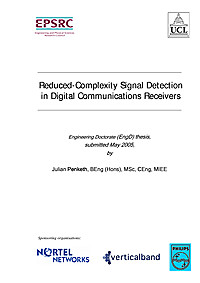
EngD thesis: Reduced-Complexity Signal Detection in Digital Communications Receivers
The Author began this Engineering Doctorate (EngD) in Autumn 1999, whilst already in full-time employment as a DSP software engineer at Nortel Networks, Harlow. This EngD comprises a set of three projects. The first project was focused on the development of dual-tone multi-frequency (DTMF) signal detection software. DTMF signals are currently used for operating menu-driven services such as voice-mail, telephone banking and share-dealing. The need for detection software in a packet networking environment exists because such signals become degraded when they travel through speech compression circuits. In addition, if they appear as echoes on a telephone line, they can affect the operation of echo cancellation systems. In this thesis a number of DSP algorithms are discussed where fast detection and minimum complexity are key characteristics. A key contribution here was the development of a novel detection algorithm based on the extraction of parameters that model the DTMF signal. The thesis reports a method combining parameter extraction with the technique of maximum likelihood to perform DTMF detection, resulting in very short time-frames when compared to standard approaches. Reducing the complexity of detection techniques is also important in today’s communication systems. To this end a key contribution here was the development of the ‘split Goertzel algorithm’, which permitted an overlapping of analysis windows without the need for reprocessing input data. Besides being applied to voice-band signals, such as in the case of DTMF, the Author also had the opportunity during the EngD to apply the skills and knowledge acquired in signal processing to higher-rate data-streams. This involved work concerning the equalisation of channel distortion commonly found in wireless communication systems. This covers two projects, with the first being conducted at Verticalband Ltd. (now no longer operational) in the area of digital television receivers. In this part of the thesis a real-time DSP implementation is discussed for enhancing a simulation system developed for wireless channels. A number of channel equalisation approaches are studied. The work concludes that for high-rate signals, non-linear algorithms have the best error rate performance. On the basis of the studies carried out, the thesis considers development and implementation issues of designs based on the decision feedback equaliser. The thesis reports on a software design which applies the method of least squares to carry out filter coefficient adaptation. The Verticalband studies reported lead on to further research within the context of channel equalisation, in the context of the detection of data in multiple-input multiple-output (MIMO) wireless local area network (WLAN) systems. This work was undertaken at Philips Research in Eindhoven, The Netherlands. The thesis discusses implementation scenarios of multi-element antenna arrays that aim to provide bit-rates orders of magnitude higher than today’s WLAN offerings, as those required by emerging standards such as 802.11n. The complexity of optimal detection techniques, such as maximum likelihood, scales exponentially with the number of transmit antennas. This translates to high processing costs and power consumption, rendering such techniques unsuitable for use in battery-powered devices. The initial main contribution here was the analysis of the complexity of algorithms whose performance had already been tested, such as the non-linear maximum likelihood approach and also less complex methods utilising linear filtering. This resulted in the development of new formulae to predict processing costs of algorithms based on the number of transmit and receive antennas. Other key contributions were defining a method to reduce the complexity of matrix inversion when using the Moore-Penrose pseudo-inverse, and the application of matrix decomposition to obviate the need for costly matrix inversion at all. Some on-going research into sub-optimal detection is also discussed, which describes methods to reduce the search-space for the maximum likelihood algorithm.


















